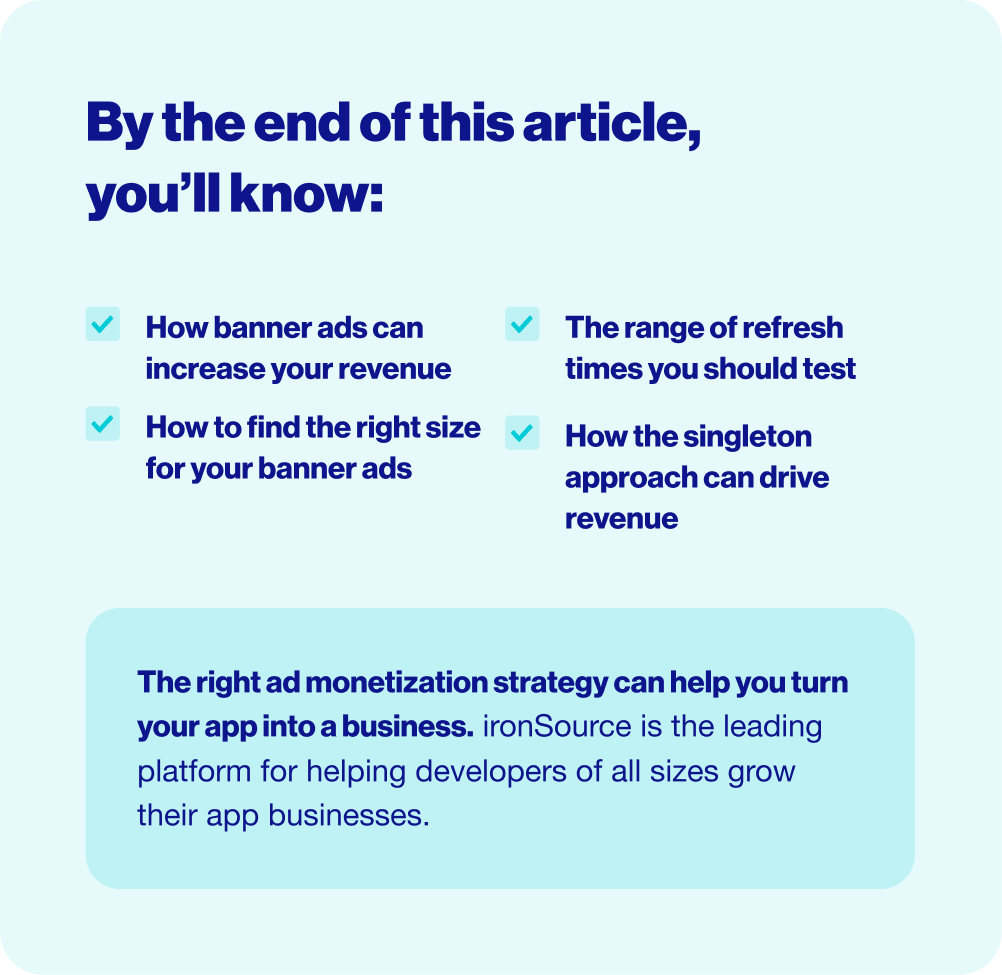When it comes to monetizing apps with ads, diversification is key. That means using a mixture of user-initiated ads like rewarded videos, and system-initiated ads like interstitials and banners, to maximize your ad revenue.
The majority of banner demand is filled by brands and agencies, so serving banner ads is a great way to expose your app traffic to brands and increase revenue. In this article, Growth Strategy Manager at ironSource, Rotem Weinberg, shares the best practices to make sure your banner ads generate the most revenue for your app while preserving a positive user experience.

1. Set the right refreshing time for your app
Mobile banner ads are typically displayed on the top or bottom of the screen, sticking to the screen for the duration of the user session. As the developer, you can set the frequency in which the banner content refreshes to show a new advertisement.
There is no one-size-fits-all approach to this: in some apps, setting the refresh time to every 30 seconds could be effective in increasing ARPDAU by maximizing exposure, while in other apps a longer refresh time could make sense. In general, the refresh time ranges from 25 seconds to 2 minutes.
Meanwhile, if you have an app with longer average play sessions, you have the luxury of being able to experiment with both short and long refresh times. The key is to A/B test frequently, measuring the impact of different refresh times on your KPIs like eCPM, ARPDAU, and retention.
2. Test different banner sizes
The size of your banner ads can have a direct impact on their overall performance. The standard banner size of 320x50 is most commonly used. This takes up minimal real estate on-screen, which is a plus for the user experience.
While standard banners are great, publishers may find higher CPMs on 'MREC' implementations, which are 250x300 Medium Rectangle banners which can fit in many menus and screens through the user session.
There are multiple sizes to choose from, however, and it's also possible to create custom sizes. The key as always is to A/B test - you can do that with the A/B testing suite on ironSource’s mediation, which offers analytics reporting so you can really drill down into your KPIs to optimize effectively.
3. Test the singleton approach
An often effective way to increase revenue from your game’s banner ads is to use the singleton approach - which refers to keeping the same banner in place throughout the app experience.
For example, if you serve the user a banner ad on the game’s homescreen, make sure this ad follows the user even as they leave the homescreen and begin navigating through new pages in the game.
Keeping your banner ads ‘sticky’ using the singleton approach helps increase revenue because it maximizes user exposure to a specific ad. Often users will scroll right past a banner or pay minimal attention to it initially, but if it follows them around the game there’s a greater likelihood of them noticing it, engaging, and ultimately generating revenue for you.
4. Use in-app bidding
To maximize the revenue your banner ad space generates, make sure you’re using in-app bidding. Bidding works as an auction, with ad networks bidding in real time to serve ads in your game. This maximizes demand from ad networks to fill your banner ad space, increasing the revenue you earn per impression.
In addition, bidding is a largely automated process, removing the burden of time-consuming manual waterfall optimization. With the considerable time this saves, you can focus your efforts on perfecting your banner placement strategy and user experience - A/B testing things like the refresh time, banner size, and the singleton approach.
Put these tips to practice: Monetize with banners on ironSource



